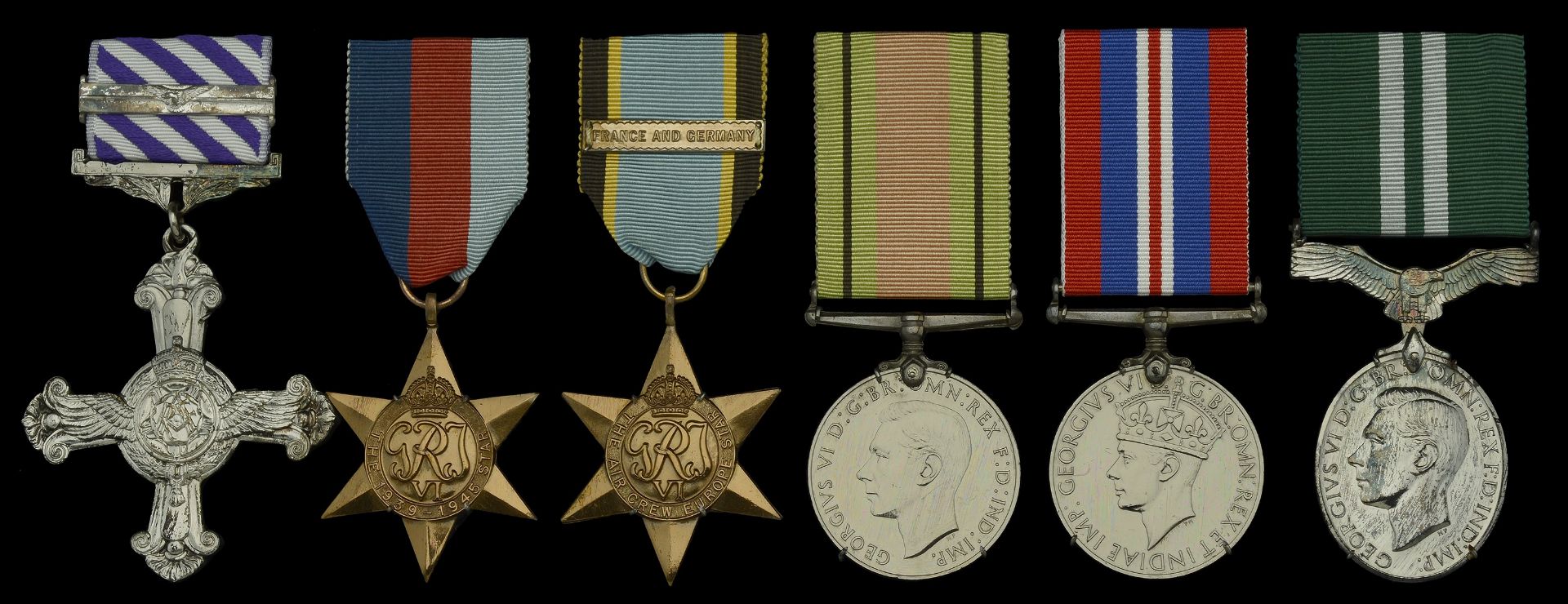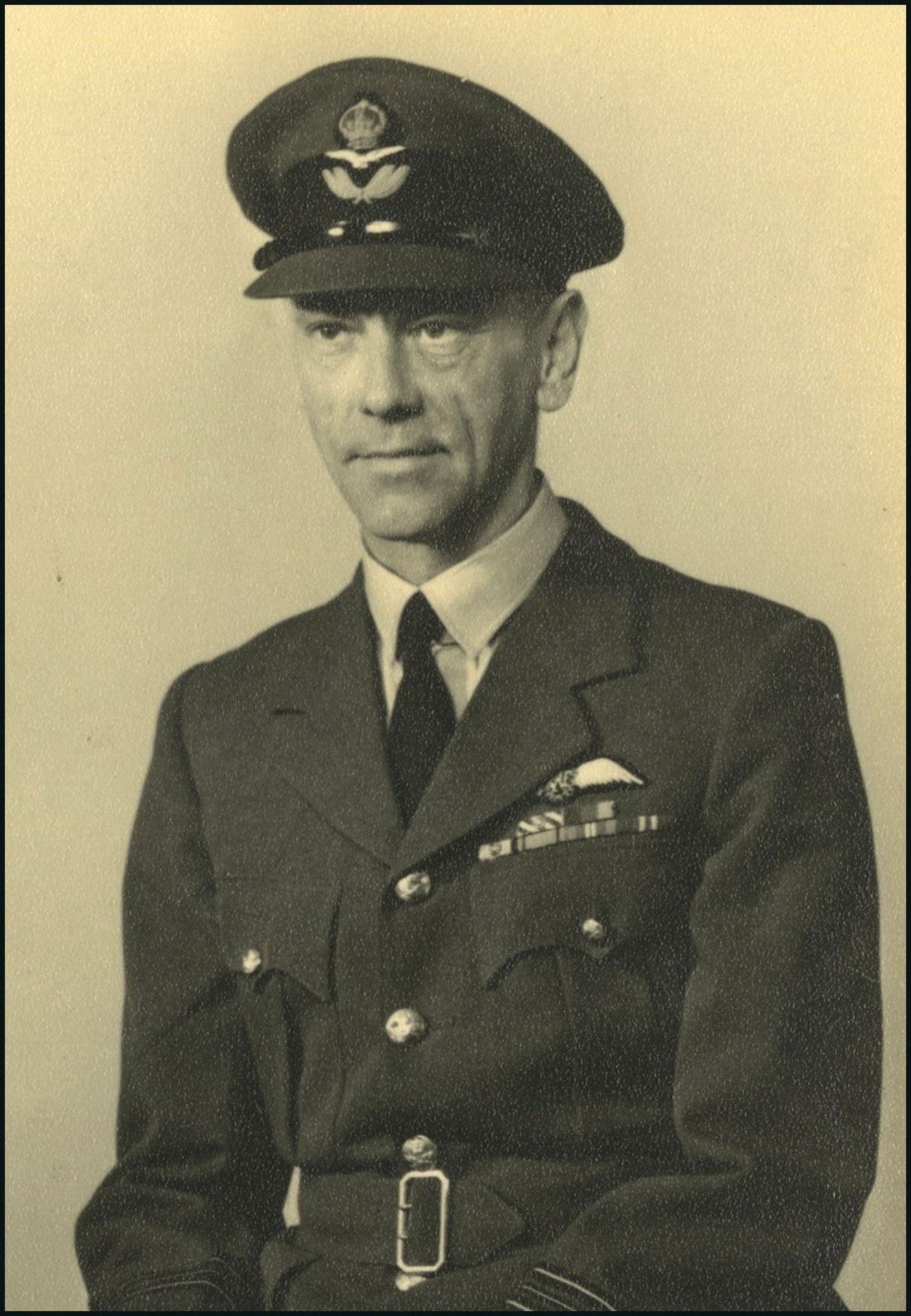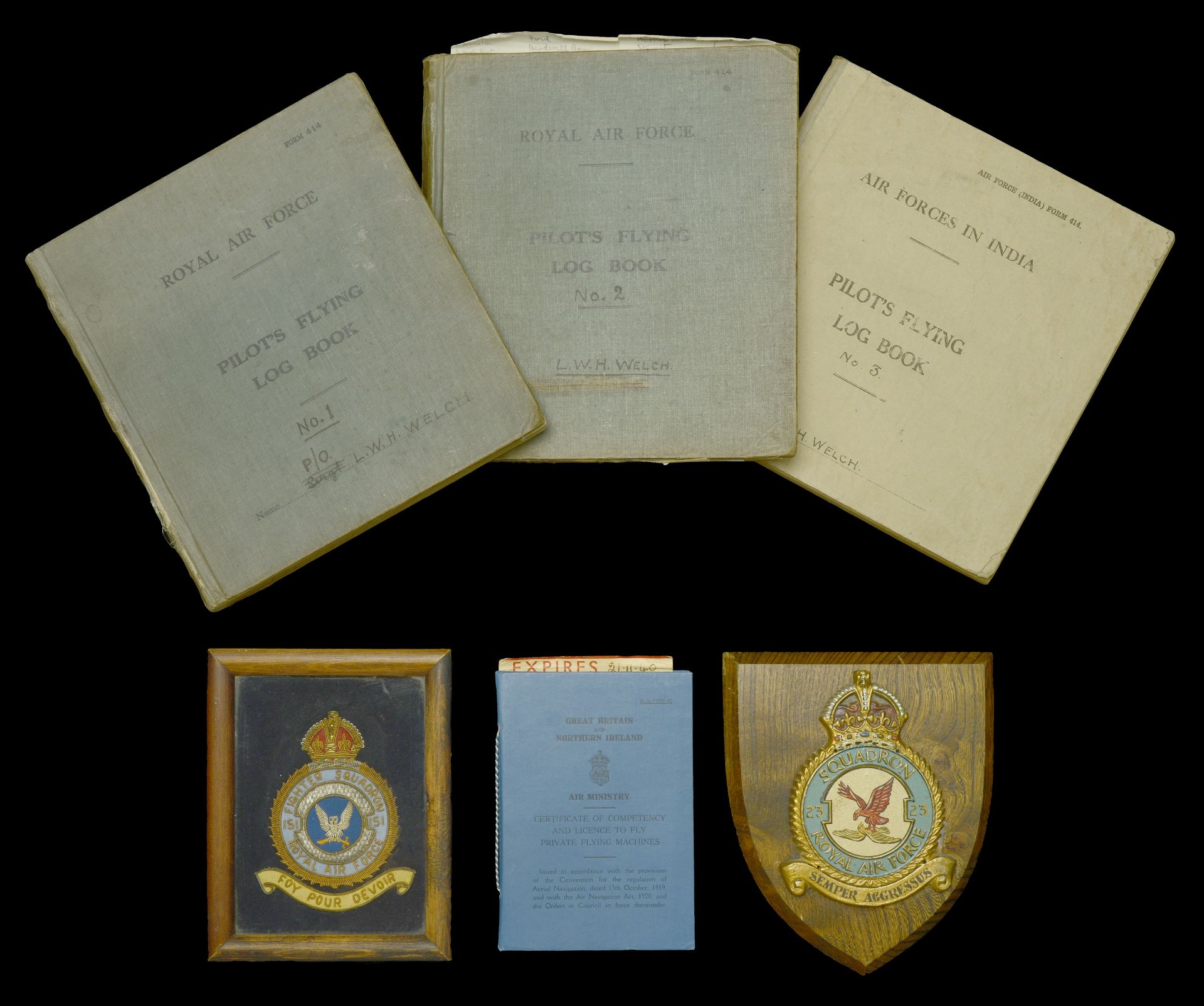A good Second War Mosquito Pilot’s D.F.C. and Second Award Bar group of six awarded to Squadron Leader L. W. H. Welch, Royal Air Force Volunteer Reserve, who flew in over 70 operational sorties with 23, 85 and 605 Squadrons, and was credited with at least 3 enemy aircraft Destroyed, 2 Damaged, 2 Destroyed on the Ground and 4 Damaged on the Ground. Welch’s gallantry was recognised with the award of a Bar to his D.F.C. when 6 of the above tally were added during a daring tree-top height raid, which he led on targets in and around Vienna, 6/7 October 1944 Distinguished Flying Cross, G.VI.R., reverse officially dated ‘1942’, with Second Award Bar, reverse officially dated ‘1945’; 1939-45 Star; Air Crew Europe Star, 1 clasp, France and Germany; Defence and War Medals 1939-45; Air Efficiency Award, G.VI.R., 1st issue (Fg. Off. L. W. H. Welch. R.A.F.V.R.) framed and glazed in a Spink & Son, St. James display case, lacquered, generally very fine or better (6) £3,000-£4,000 --- D.F.C. London Gazette 29 December 1942 (jointly listed with Flying Officer W. R. Shuttleworth): ‘In December, 1942, Flight Lieutenant Welch and Flying Officer Shuttleworth, as pilot and navigator of aircraft respectively, undertook a sortie into enemy territory. Despite adverse weather, success was achieved. At least 2 enemy aircraft were destroyed. The skilful execution of the operation reflects great credit on the efforts of these two officers. Both Flight Lieutenant Welch and Flying Officer Shuttleworth have completed numerous sorties over enemy territory.’ D.F.C. Second Award Bar London Gazette 9 January 1945: ‘Squadron Leader Welch has completed much operational flying. He has set a splendid example of skill, keenness and gallantry and has shown the utmost devotion to duty. In October, 1944, he participated in an attack on an airfield in Austria. In spite of intense anti-aircraft fire, Squadron Leader Welch was responsible for the destruction of 2 enemy aircraft. His own aircraft was hit but he flew safely to base, despite fighter interference on the homeward flight. On this notable sortie, Squadron Leader Welch displayed exceptional skill and resolution.’ Leonard William Henry Welch was born in South Stoneham, Hampshire in June 1908. He joined the Royal Air Force Volunteer Reserve as a Sergeant Pilot in May 1937. Welch carried out initial training at Hamble, and undertook an instructor’s course at Redhill in October 1939. He was posted as an Instructor to No. 1 E.F.T.S., Hatfield in December 1939, and remained employed in this capacity at various stations and O.T.U.’s until June 1942. On the latter date Welch was posted as Flying Officer for operational service with 23 Squadron (Mosquitoes) at Ford. The Squadron pioneered long-range intruder operations over Northern Europe, and Welch flew on at least 21 with them, including 4 September 1942 ‘Intruder - Melun. Me. 210 Chased & Lost. Unidentified E/A Chased Down V/L + Cannons Fired; Strikes Seen. “Damaged”.’ (Log Book refers) Welch also attacked a train south of Amiens, 18/19 September 1942, resulting in ‘Vivid Flash From One Truck.’ (Ibid) He suffered an engine failure off the French Coast, and crawled home with ‘Petrol Gauge Reading Zero - Whew!’, 24/25 October 1942. The following month he carried out 6 attacks on trains, damaging at least 4 of them. Welch, and his now regular navigator - Flying Officer R. Shuttleworth, achieved their greatest haul, 8 December 1942, when they Destroyed 2 enemy aircraft, and Damaged 2 others during one intruder operation. His Log Book, which has two photographs of the aircraft sustaining damage added, gives the following: ‘Intruder - Bourges, Avord - No Activity. Orleans - Strikes On FW. 200 - “Damaged.” Blew Port Wing Off Ju. 87 - “Destroyed.” Strikes On Bucker 131 - “Damaged.” Hit 2nd Bucker 131; Followed It Down And After 2nd Squirt Stbd Wing Came Off - “Destroyed.” Very Inaccurate Flak From Bricy A/D. Chateaudun: - Useless Extreme Range Squirt At FW. 200. Light Flak From A/D Very Close. Landed Ford. - D.F.C.’ Both Welch and Shuttleworth were to receive the D.F.C. for the above action, however, they were on the receiving end from a FW. 190, 28 December 1942, ‘Intruder - Rennes, No Activity. Vannes, Attacked by FW. 190. Stbd Wing Hit; Evaded & Climbed Into Cloud. Landed Predannack.’ Welch and Shuttleworth were posted to 605 Squadron operating from Heston in January 1943, but were almost immediately attached to 85 Squadron operating from Hunsdon. Welch flew on 11 operational sorties with the latter, including 3 May 1943, ‘Intruder - Dijon, Chalon. No Activity. Fired At Leaving French Coast. Attacked By Two FW. 190’s In Mid-Channel. No Cloud Cover. Evasive Tactics Till 190’s Broke Off Engagement. Hit Twice - Elevator, Rear Of Fuselage, Port Wing (Inner Fuel Tank), And Port Airscrew, Frightened By Two Typhoons. Had To Feather Port Airscrew. Hydraulics U/S. Crash-Landed Ford.’ (Ibid) Welch finally returned to fly with 605 Squadron from Castle Camps in June 1943. He flew a further 9 operational sorties with the Squadron, including two Special Ops for 80 Wing (a radio counter-measures unit), before the completion of his 1st tour in August 1943. After a posting to 60 O.T.U., and then 13 O.T.U., Welch returned to operational flying with 605 Squadron at Manston in May 1944. He was crewed with Flying Officer L. R. Page, D.F.M. and Bar, and added to his tally 27 May 1944, ‘Distil - Heligoland Bight With S/L Geoff Wright. Met 4 Mine-Sweeping Ju. 52’s Off Wangerooge. Geoff Got Two, I Got One. Plenty Flak From Ships And Shore - One Destroyed.’ Welch and Page flew in support of the D-Day Landings, and a large number of ‘Diver Patrols’ and ‘Rangers’ from July 1944. Welch was appointed as a Flight Commander in August, and was to be awarded the Bar to his D.F.C. for taking part in a two aircraft raid over targets in Vienna, 6/7 October 1944. The daring raid was recorded in the Daily Mirror, 9 October 1944 (cutting included with the lot) thus: ‘Tree-top flyers from Britain gave Vienna a shock. Two Mosquitoes flew all the way from Britain to Vienna at tree-top height. And in six minutes they were over their airfield targets on Saturday they smashed up ten German planes, and severely damaged six others. The flight took seven hours and meant a round trip of 1,700 miles. Pilot of Mosquito No. 1 was Squadron Leader L. W. H. Welch, D.F.C., of Tunbridge Wells, Kent, a pre-war newspaper reporter. His observer was Flying Officer L. R. Page, D.F.M. and Bar, of Ipswich. “We flew at tree-top height all the way without seeing a solitary Hun”, Squadron Leader Welch said last night. “As we neared Vienna there seemed to be a lot of activity. People looked up and waved to us - then they made a mad dash in all directions. One large air park was packed with enemy machines bunched together all over the place. We just swooped down and sprayed them with cannon and left them a smouldering mass of wreckage.” The other Mosquito was piloted by Flight Lieutenant A. J. Craven. Welch’s Log Book gives the following additional information: ‘Ranger Vienna Area. No A/C Seen At Tulln: Accurate Heavy Flak. Two Ju. 52’s Destroyed (Flamers) On Ground At Fischamend Markt: Accurate Light Flak. At Münchendorf, One Me. 108 Damaged As It Was Landing; Two Ju. 87’s And One He. III Damaged On Ground: Holed By Heavy Flak While Diving For Another Attack; A.S.I. U/S So Packed Up. Attacked By Fighters On Return Trip; Evaded & Found Cloud Cover. Landed ...










